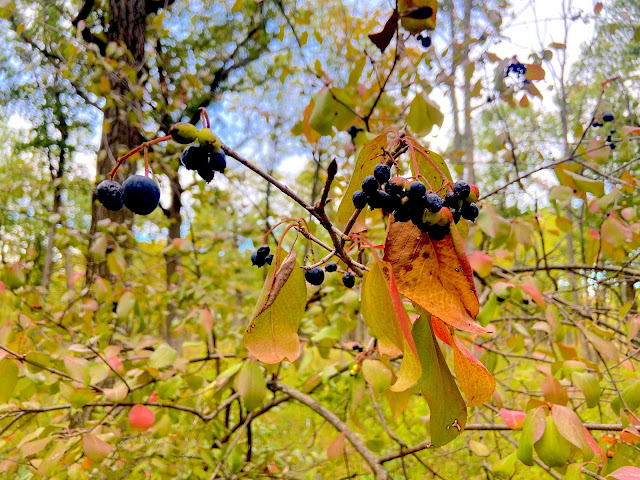 |
| Internet photo of Hermit Thrush eating fruits, though not wild raisins |
 |
| Here's what those fruits look like. Tasty to us too, even after they dry. |
 |
| And here's what the tree looks like. Would you notice it? |
This seems to be Somme's only black haw that is big and healthy enough to produce fruit. When restoration started, black haw was the commonest shrub or understory tree in this woods. There's an interesting comparison with the sunnier Somme Prairie Grove, where the commonest shrubs were gray dogwood, hazelnut, nannyberry, sumach, and New Jersey tea. Small numbers of those shrubs were at Somme Woods when we first explored it. But they all dropped out, likely from too much shade, before the restoration reached them. Black haws seem to have survived the shade best, but only as few-inch-tall sprouts from spreading roots, hoping to pop up somewhere with more sun. These days they have plenty of sun, but the excessive deer population eats down all except the few that we protect with exclusion cages, as we once protected the one shown above.
And we always seem to pause for thoughts at our biggest tree, shown below:
 |
Photos don't do justice to this big bur oak. The trees around it are big, but it dwarfs them. To measure its girth with our arms, it takes three or more of us. |
Hundreds of years old, this matriarch is nearing the end of her life, superficially speaking. But after the tree organism stops photosynthesizing, it will live on for decades as a home, food source, and habitat for woodpeckers, beetles, hawks, owls, fungi, and massively more. But also significant - "end-of-life-wise" - is the fact that there are no other bur oaks nearby - either old trees or seedlings. This area had been shady too long. And the restoration is not advanced enough yet for bur oak reproduction. Thus - a race against time.
Next came a fox squirrel.
For years we've wondered if they would replace the gray squirrels, as the pre-restoration chaos of "Unassociated Woody Growth" evolved toward fox squirrel habitats of savanna and open oak woodland. Not so far. On this walk two fox squirrels were outnumbered by at least thirty gray squirrels. This subject seems to deserve its own separate post. Coming soon.
Squirrels are our only mammals fully active in daytime. That's partly why we learn more diverse habitat lessons from birds.
Here's the list of the birds along the East Loop trail today:
Yellow-rumped warblers 5
White-throated sparrows 8
Juncos 14
Chickadee 1
Not very many birds actually. But it was the middle of the day, when birds are less active. Frequently in this area I see red-bellied woodpeckers, red-headed woodpeckers, a pileated woodpeckers or two, nuthatches, blue jays, red-tailed hawks, and others.
Then came Fourth Pond, where there was a full-fledged Wild-life Wild-party under way. Birds here included:
Yellow-rumped warbler 11
Song sparrow 1
Juncos 7
White-throated sparrow 14
White-breasted nuthatch 1
Red-belied woodpecker 2
Red-headed woodpecker 4 (one adult and three black-headed young)
Hairy woodpecker 1
Downy woodpecker 1
Goldfinch 5
Hermit thrush 1
Blue jay 2
All were gloriously active, not drinking water, but finding food.
This ephemeral pond was dark, dank, and bereft of animals and plants before the restoration began. It had been heavily used by cows for decades, and its bare perimeter sprouted massively with cottonwoods when the Forest Preserve District bought this land and sent those cows elsewhere. Cottonwoods and buckthorn irrupted and made that darkness and damp.
After this dry summer, the pond is perhaps 5% the size it is in spring after snowmelt. But, full or dry, it's rich with life all year long. Opening this pond to sunlight has made a splendid difference.
This post ends with credits, headed up by those for restoration.
Restoration credits
Rebeccah Hartz is the zone steward for Fourth Pond zone.
Forest Preserve staff gets credit for girdling those greedy cottonwoods.
Volunteer restoration crews have done the rest, workday by workday, over decades.
Related posts
On the girdling of the trees and this pond's one year of fish
On seeding the now-glorious nearby Fourth Pond Meadow
Photo credit
Hermit thrush: Birds of the World


No comments:
Post a Comment